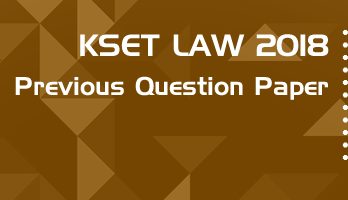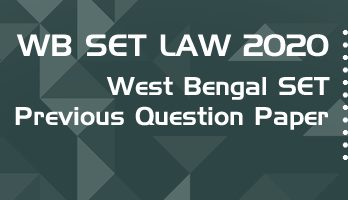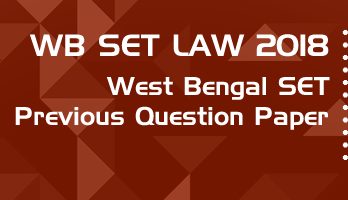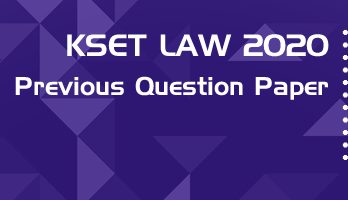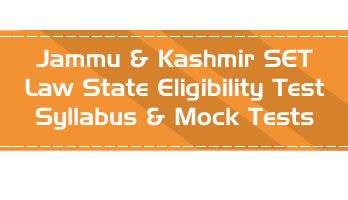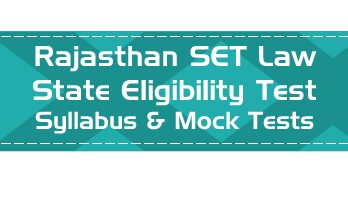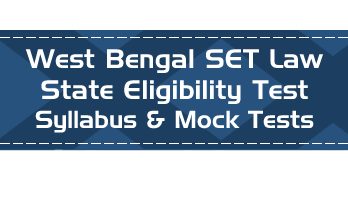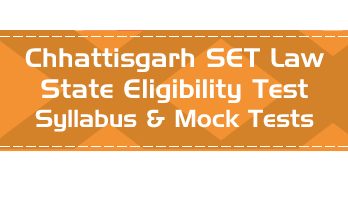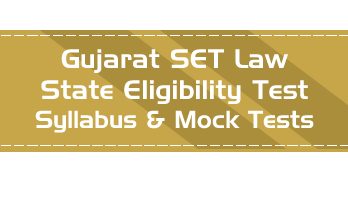- Based on latest Telangana State Eligibility Test Law Paper II Syllabus
- Law Subjects Overview Material covering important topics and concepts - 650 page PDF Book
- 50 Full Length Mock Tests - New Pattern Paper II, with 100 questions each
- 50 Mini Practice Mock tests - with 25 questions each
- Unlimited Practice - New Questions in every mock test with every attempt
- Answer choices of all questions shuffled randomly for better practice
- Database of over 9500 MCQs covering the entire syllabus
- Includes new comprehension based questions
- Questions & Answer Choices randomly shuffled in every attempt for better practice
- Accessible 24 x 7 via Smart-Phone browsers and Desktops
"Just wanted to let you know that I have cleared JRF with 99.99th percentile. Thank you for all your help and support that made it possible. " - Kanchan Yadav
"Thank you so much for the UGC NET test series. I finally qualified the exam. It was possible because of the mock test series provided by your team." - Robin Jaiswal
This previous question paper is Law Paper II from the TS SET 2012 – Telangana State Eligibility Test that was conducted in 2012.
The pattern of the TS SET Law has been changed from 2018 onward, where the previous paper III has been removed and the scope of Paper II has been increased from 50 questions to 100 questions.
The questions from this paper are included in the database for the LawMint.com TS SET Law Online Practice pack.
Check out the latest official syllabus of the TS SET Law in this article : TS SET Law Syllabus and Details.
Note : The syllabus for the UGC NET papers 1 & 2 has been changed since Jan 2019; so the syllabus for this exam is also expect to change.
TS SET Law Previous Question Paper II 2012
1. The three new concepts ‘secularism, socialism and integrity’ have been inserted in the preamble through
(A) 38th Amendment
(B) 40th Amendment
(C) 42nd Amendment
(D) 44th Amendment
2. The following fundamental rights are not available to aliens
(A) Art. 14, 15, 19
(B) Art.15, 16, 19
(C) Art. 16, 19, 21
(D) Art. 14, 19, 21
3. The Parliament shall consist of
(A) President, Council of States and House of the People
(B) President, Council of States and Prime Minister
(C) President, Prime Minister and Council of Ministers
(D) Prime Minister, Council of States and House of the People
4. The right to freedom of religion guaranteed in Article 25 of the Constitution of India is subject to which of the following ?
(A) Public order, morality and to the other provisions of Part III of the Constitution of India
(B) Public order, morality and health
(C) Reasonableness restrictions in the interests of the security of the State
(D) Public order, morality and health and to the other provisions of Part III of the Constitution of India
5. Which one of the following statements is correct ? Emergency shall :
(A) be proclaimed by the President on his satisfaction
(B) be proclaimed by the President on the basis of the recommendation of the Union Cabinet
(C) be declared under Article 353
(D) continue for a maximum period of three years
6. Match List I with List II and select the correct answer from the codes given below the Lists :
List I
A. Basic structure of the Constitution cannot be amended
B. A law made by legislature to deprive a person of his personal liberty must be just, fair and reasonable
C. Advisory opinion of Supreme court is also binding on all courts
D. President satisfaction under Art. 356 is judicially reviewable to a limited extent
List II
1. In reference to Special Court Bill 1978
2. Kesavanand Bharathi v. State of Kerala
3. S.R. Bommai v. Union of India
4. Maneka Gandhi v. Union of India
A B C D
(A) 2 4 1 3
(B) 2 4 3 1
(C) 1 2 3 4
(D) 1 2 4 3
7. At the time of formation of Israel, there was a dispute between Israel and Palestine and other Arab countries. United Nations Organisation acted as a mediator in the dispute between Israel and Palestine. It sent a team to pacify the enemeties between them. Count Folke Bernadottea Swedish national was the head of the UN Truce Negotiation team. On 17-9-1948, he was murdered by terrorists. The ICJ ordered Israel to pay compensation to UN for the death of Bernadotte. Refer caselaw
(A) Reparation for injuries suffered in the services of the United Nations case
(B) Attorney General of the Government of Israel v. Eichmann
(C) The Nuremberg trial
(D) Advisory opinion of the ICJ on Reservation of the Genocide convention
8. The given item consists of two statements one labelled as the ‘Assertion (A)’ and the other as ‘Reason (R)’. Examine these two statements carefully and select the answers to these items using the codes given below :
Assertion (A) : The International Court of Justice is the principal organ of the UN
Reason (R) : The International Court of Justice has compulsory jurisdiction over all the members of UN
(A) Both A and R are individually true and R is the correct explanation of A
(B) Both A and R are individually true, but R is not the correct explanation of A
(C) A is true, but R is false
(D) A is false, but R is true
9. ‘Jus cogens’ means
(A) peremptory norms of general international law from which no derogation is permissible
(B) rules of ancient customary international law which are rendered redundant in modern times
(C) abrogation of a rule in a treaty by a subsequent treaty
(D) rule developed from a bilateral treaty which has found universal
10. Match List I with List II and select the correct answer from the codes given below the Lists :
List I
A. The conception of one world
B. The term ‘International Law’ was coined by
C. The Franconia
D. Pacta Sunt Servanda
List II
1. Jeremy Bentham
2. Wendell Wilkie
3. Anzilotti
4. Lord Coleridge
Codes : A B C D
(A) 1 3 2 4
(B) 3 2 4 1
(C) 2 1 4 3
(D) 4 1 2 3
11. The U.N.O. has been prohibited from intervening in matters which are essentially within the domestic jurisdiction of any State. Yet the
(A) Security Council can intervene when it decides on enforcement action
(B) Security Council can intervene to stop religious strife in a country
(C) General Assembly can intervene under the ‘uniting for peace’ Resolution
(D) Security Council can intervene for the release of hostage taken by a State
12. Which of the following is among the purpose of the UN as laid down in Article 1 of the U.N. charter ?
I. To maintain international peace and security
II. To develop friendly relation among nations
III. To ensure that non-members of the United Nations Act in accordance with the U.N. charter
IV. To achieve international co-operation in solving international problems of an economic social cultural or humanitarian character
(A) I, II, III are correct
(B) I, III, IV are correct
(C) I, II, IV are correct
(D) II, III, IV are correct
13. That a legal system arises from the combination of primary and secondary rules was enunciated by
(A) Austin
(B) Hart
(C) Bentham
(D) Kelsen
14. Which one of the schools of jurisprudence considers that ‘a reasoned scale of values can be discovered as a basis for legal development’ ?
(A) Analytical
(B) Philosophical
(C) Historical
(D) Sociological
15. Consider the following statements with regard to natural law
1. The central notion of natural law is the existence of objective moral principles
2. These principles are discovered by reference to legal sources as the constitution, codes and so on
3. These principles depend on the essential nature of man
(A) 1, 2, 3 are correct
(B) 1, 2 are correct
(C) 2, 3 are correct
(D) 1, 3 are correct
16. Which of the following statements are correct ?
I. Ownership can be legal and vested ownership
II. Ownership can be legal and equitable ownership
III. Ownership can be trust and beneficial ownership
Select the correct answer
(A) I and II
(B) I and III
(C) I, II and III
(D) II and III
17. Kelsen’s theory of law is called pure theory because Kelsen
(A) Purely discussed jurisprudence only
(B) Defined law in accordance with morality and purity
(C) Separated law from religion, ethics, sociology and history
(D) Discussed law purely in terms of justice
18. “Law as such is found and not made. It is to be found in popular faith, common convictions, customs, traits, habits, traditions which in course of time grow into legal rules”. This concept was propounded by
(A) Thibaut
(B) Henry Maine
(C) Savingny
(D) Salmond
19. Which among the following is recently declared as a ground for divorce for Hindu’s by the Supreme Court of India
(A) Cruelty
(B) Conversion
(C) Irretrievable break down of marriage
(D) Mutual consent
20. Match List I with List II and select the correct answer from the codes given below the Lists :
List I
I. Gita Hariharan v. Reserve Bank of India
II. Bai Tahira v. Ali Hussain
III. Md. Amin v. Vakil Ahmed
IV. Dastane v. Dastane
List II
1. Marriage
2. Divorce
3. Maintenance
4. Guardianship
Codes : I II III IV
(A) 1 4 3 2
(B) 2 3 4 1
(C) 3 4 2 1
(D) 4 3 1 2
21. Arrange the following sources of Hindu Law sequentially in the chronological order
I. Dharma Sutra
II. Custom
III. Veda
IV. Dharma Shastra
(A) III, II, IV, I
(B) IV, III, II, I
(C) III, I, IV, II
(D) II, III, IV, I
22. Select the correct statements from the following
I. Hindu marriage requires compulsory registration
II. Mohammedans marriage requires compulsory registration
III. Special Marriage Act mandates compulsory registration
IV. All the above are correct
(A) IV (B) II and III
(C) I and II (D) I and III
23. Which among the following provides for penal consequences if marriage is solemnised between a female aged below 18 years and a male aged below 21 years ?
(A) Special Marriage Act 1954
(B) Hindu Marriage Act 1955
(C) Child Marriage Restraint Act 1929
(D) Christian Marriage Act 1872
24. Which among the following is not a source of Mohammedan Law ?
(A) Koran
(B) Hadith
(C) Qiyas
(D) Shariat
25. Which among the following is the source of Mohammedan Law derived from the Islamic jurists analogical deductions ?
(A) Koran
(B) Hadith
(C) Qiyas
(D) Shariat


